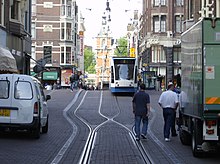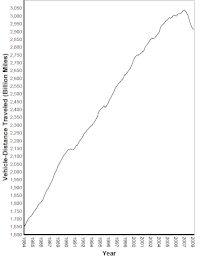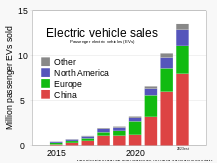Sustainable transport
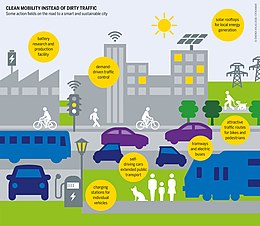
| Part of a series on |
| Sustainable energy |
|---|
 |
Sustainable transport refers to ways of transportation that are sustainable in terms of their social and environmental impacts. Components for evaluating sustainability include the particular vehicles used for road, water or air transport; the source of energy; and the infrastructure used to accommodate the transport (roads, railways, airways, waterways, canals and terminals). Transport operations and logistics as well as transit-oriented development are also involved in evaluation.[citation needed] Transportation sustainability is largely being measured by transportation system effectiveness and efficiency as well as the environmental and climate impacts of the system.[1] Transport systems have significant impacts on the environment, accounting for between 20% and 25% of world energy consumption and carbon dioxide emissions.[2] The majority of the emissions, almost 97%, came from direct burning of fossil fuels.[3] In 2019, about 95% of the fuel came from fossil sources. The main source of greenhouse gas emissions in the European Union is transportation. In 2019 it contributes to about 31% of global emissions and 24% of emissions in the EU. In addition, up to the COVID-19 pandemic, emissions have only increased in this one sector.[4][5] Greenhouse gas emissions from transport are increasing at a faster rate than any other energy using sector.[6] Road transport is also a major contributor to local air pollution and smog.[7]
Sustainable transport systems make a positive contribution to the environmental, social and economic sustainability of the communities they serve. Transport systems exist to provide social and economic connections, and people quickly take up the opportunities offered by increased mobility,[8] with poor households benefiting greatly from low carbon transport options.[9] The advantages of increased mobility need to be weighed against the environmental, social and economic costs that transport systems pose. Short-term activity often promotes incremental improvement in fuel efficiency and vehicle emissions controls while long-term goals include migrating transportation from fossil-based energy to other alternatives such as renewable energy and use of other renewable resources. The entire life cycle of transport systems is subject to sustainability measurement and optimization.[10]
The United Nations Environment Programme (UNEP) estimates that each year 2.4 million premature deaths from outdoor air pollution could be avoided.[11] Particularly hazardous for health are emissions of black carbon, a component of particulate matter, which is a known cause of respiratory and carcinogenic diseases and a significant contributor to global climate change.[12] The links between greenhouse gas emissions and particulate matter make low carbon transport an increasingly sustainable investment at local level—both by reducing emission levels and thus mitigating climate change; and by improving public health through better air quality.[12] The term "green mobility" also refers to clean ways of movement or sustainable transport.[13]
The social costs of transport include road crashes, air pollution, physical inactivity,[14] time taken away from the family while commuting and vulnerability to fuel price increases. Many of these negative impacts fall disproportionately on those social groups who are also least likely to own and drive cars.[15] Traffic congestion imposes economic costs by wasting people's time and by slowing the delivery of goods and services. Traditional transport planning aims to improve mobility, especially for vehicles, and may fail to adequately consider wider impacts. But the real purpose of transport is access – to work, education, goods and services, friends and family – and there are proven techniques to improve access while simultaneously reducing environmental and social impacts, and managing traffic congestion.[16] Communities which are successfully improving the sustainability of their transport networks are doing so as part of a wider program of creating more vibrant, livable, sustainable cities.
Definition
[edit]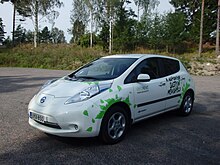
The term sustainable transport came into use as a logical follow-on from sustainable development, and is used to describe modes of transport, and systems of transport planning, which are consistent with wider concerns of sustainability. There are many definitions of the sustainable transport, and of the related terms sustainable transportation and sustainable mobility.[17] One such definition, from the European Union Council of Ministers of Transport, defines a sustainable transportation system as one that:
- Allows the basic access and development needs of individuals, companies and society to be met safely and in a manner consistent with human and ecosystem health, and promotes equity within and between successive generations.
- Is affordable, operates fairly and efficiently, offers a choice of transport mode, and supports a competitive economy, as well as balanced regional development.
- Limits emissions and waste within the planet's ability to absorb them, uses renewable resources at or below their rates of generation, and uses non-renewable resources at or below the rates of development of renewable substitutes, while minimizing the impact on the use of land and the generation of noise.
Sustainability extends beyond just the operating efficiency and emissions. A life-cycle assessment involves production, use and post-use considerations. A cradle-to-cradle design is more important than a focus on a single factor such as energy efficiency.[18][19]
Benefits
[edit]Sustainable transport has many social and economic benefits that can accelerate local sustainable development. According to a series of serious reports by the Low Emission Development Strategies Global Partnership (LEDS GP), sustainable transport can help create jobs,[20] improve commuter safety through investment in bicycle lanes, pedestrian pathways and non-pedestrian pathways,[21] make access to employment and social opportunities more affordable and efficient. It also offers a practical opportunity to save people's time and household income as well as government budgets,[22] making investment in sustainable transport a 'win-win' opportunity.
Environmental impact
[edit]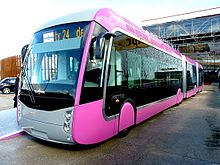

Transport systems are major emitters of greenhouse gases, responsible for 23% of world energy-related GHG emissions in 2004, with about three-quarters coming from road vehicles. Data from 2011 stated that one-third of all greenhouse gases produced are due to transportation.[24] Currently 95% of transport energy comes from petroleum.[6] Energy is consumed in the manufacture as well as the use of vehicles, and is embodied in transport infrastructure including roads, bridges and railways.[25] Motorized transport also releases exhaust fumes that contain particulate matter which is hazardous to human health and a contributor to climate change.[26]
The first historical attempts of evaluating the Life Cycle environmental impact of vehicle is due to Theodore Von Karman.[27] After decades in which all the analysis has been focused on emending the Von Karman model, Dewulf and Van Langenhove have introduced a model based on the second law of thermodynamics and exergy analysis.[28] Chester and Orwath,[29][30][31] have developed a similar model based on the first law that accounts the necessary costs for the infrastructure.
The environmental impacts of transport can be reduced by reducing the weight of vehicles,[32] sustainable styles of driving, reducing the friction of tires, encouraging electric and hybrid vehicles, improving the walking and cycling environment in cities, and by enhancing the role of public transport, especially electric rail.[6]
Green vehicles are intended to have less environmental impact than equivalent standard vehicles, although when the environmental impact of a vehicle is assessed over the whole of its life cycle this may not be the case.[33]
Electric vehicle technology significantly reduces transport CO2 emissions when comparing battery electric vehicles (BEVs) with equivalent internal combustion engine vehicles (ICEVs).[34] The extent to which it does this depends on the embodied energy of the vehicle and the source of the electricity.[34] Lifecycle greenhouse gas emission reductions from BEVs are significant, even in countries with relatively high shares of coal in their electricity generation mix, such as China and India.[34][35] As a specific example, a Nissan Leaf in the UK in 2019 produced one third of the greenhouse gases than the average internal combustion car.[36]


The Online Electric Vehicle (OLEV), developed by the Korea Advanced Institute of Science and Technology (KAIST), is an electric vehicle that can be charged while stationary or driving, thus removing the need to stop at a charging station. The City of Gumi in South Korea runs a 24 km roundtrip along which the bus will receive 100 kW (136 horsepower) electricity at an 85% maximum power transmission efficiency rate while maintaining a 17 cm air gap between the underbody of the vehicle and the road surface. At that power, only a few sections of the road need embedded cables.[38] Hybrid vehicles, which use an internal combustion engine combined with an electric engine to achieve better fuel efficiency than a regular combustion engine, are already common.
Natural gas is also used as a transport fuel, but is a less promising technology as it is still a fossil fuel and still has significant emissions (though lower than gasoline, diesel, etc.).
Brazil met 17% of its transport fuel needs from bioethanol in 2007, but the OECD has warned that the success of (first-generation) biofuels in Brazil is due to specific local circumstances. Internationally, first-generation biofuels are forecast to have little or no impact on greenhouse emissions, at significantly higher cost than energy efficiency measures.[39] The later generation biofuels however (2nd to 4th generation) do have significant environmental benefit, as they are no driving force for deforestation or struggle with the food vs fuel issue.
In practice there is a sliding scale of green transport depending on the sustainability of the option. Green vehicles are more fuel-efficient, but only in comparison with standard vehicles, and they still contribute to traffic congestion and road crashes. Well-patronized public transport networks based on traditional diesel buses use less fuel per passenger than private vehicles, and are generally safer and use less road space than private vehicles.[40] Green public transport vehicles including electric trains, trams and electric buses combine the advantages of green vehicles with those of sustainable transport choices. Other transport choices with very low environmental impact are cycling and other human-powered vehicles, and animal powered transport. The most common green transport choice, with the least environmental impact is walking.
Transport on rails boasts an excellent efficiency (see fuel efficiency in transportation).
Transport and social sustainability
[edit]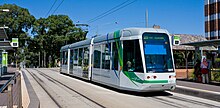
Cities with overbuilt roadways have experienced unintended consequences, linked to radical drops in public transport, walking, and cycling. In many cases, streets became void of "life." Stores, schools, government centers and libraries moved away from central cities, and residents who did not flee to the suburbs experienced a much reduced quality of public space and of public services. As schools were closed their mega-school replacements in outlying areas generated additional traffic; the number of cars on US roads between 7:15 and 8:15 a.m. increases 30% during the school year.[41]
Yet another impact was an increase in sedentary lifestyles, causing and complicating a national epidemic of obesity, and accompanying dramatically increased health care costs.[14][42]
Car-based transport systems present barriers to employment in low-income neighbourhoods,[43] with many low-income individuals and families forced to run cars they cannot afford to maintain their income.[44]
Potential shift to sustainable transport in developing countries
[edit]In developing countries such as Uganda, researchers have sought to determine factors that could possibly influence travelers to opt for bicycles as an alternative to motorcycle taxis (Bodaboda). The findings suggest that generally, the age, gender, and ability of the individual to cycle in the first place are key determinants of their willingness to shift to a more sustainable mode. Transport system improvements that could reduce the perceived risks of cycling were also seen to be the most impactful changes that could contribute towards the greater use of bicycles.[45]
Cities
[edit]
Cities are shaped by their transport systems. In The City in History, Lewis Mumford documented how the location and layout of cities was shaped around a walkable center, often located near a port or waterway, and with suburbs accessible by animal transport or, later, by rail or tram lines.
In 1939, the New York World's Fair included a model of an imagined city, built around a car-based transport system. In this "greater and better world of tomorrow", residential, commercial and industrial areas were separated, and skyscrapers loomed over a network of urban motorways. These ideas captured the popular imagination, and are credited with influencing city planning from the 1940s to the 1970s.[46]

The emergence of the car in the post-war era led to major changes in the structure and function of cities.[47] There was some opposition to these changes at the time. The writings of Jane Jacobs, in particular The Death and Life of Great American Cities provide a poignant reminder of what was lost in this transformation, and a record of community efforts to resist these changes. Lewis Mumford asked "is the city for cars or for people?"[48] Donald Appleyard documented the consequences for communities of increasing car traffic in "The View from the Road" (1964) and in the UK, Mayer Hillman first published research into the impacts of traffic on child independent mobility in 1971.[49] Despite these notes of caution, trends in car ownership,[50] car use and fuel consumption continued steeply upward throughout the post-war period.
Mainstream transport planning in Europe has, by contrast, never been based on assumptions that the private car was the best or only solution for urban mobility. For example, the Dutch Transport Structure Scheme has since the 1970s required that demand for additional vehicle capacity only be met "if the contribution to societal welfare is positive", and since 1990 has included an explicit target to halve the rate of growth in vehicle traffic.[51] Some cities outside Europe have also consistently linked transport to sustainability and to land-use planning, notably Curitiba, Brazil, Portland, Oregon and Vancouver, Canada.

There are major differences in transport energy consumption between cities; an average U.S. urban dweller uses 24 times more energy annually for private transport than a Chinese urban resident, and almost four times as much as a European urban dweller. These differences cannot be explained by wealth alone but are closely linked to the rates of walking, cycling, and public transport use and to enduring features of the city including urban density and urban design.[52]

The cities and nations that have invested most heavily in car-based transport systems are now the least environmentally sustainable, as measured by per capita fossil fuel use.[52] The social and economic sustainability of car-based transportation engineering has also been questioned. Within the United States, residents of sprawling cities make more frequent and longer car trips, while residents of traditional urban neighborhoods make a similar number of trips, but travel shorter distances and walk, cycle and use transit more often.[53] It has been calculated that New York residents save $19 billion each year simply by owning fewer cars and driving less than the average American.[54] A less car intensive means of urban transport is carsharing, which is becoming popular in North America and Europe, and according to The Economist, carsharing can reduce car ownership at an estimated rate of one rental car replacing 15 owned vehicles.[55] Car sharing has also begun in the developing world, where traffic and urban density is often worse than in developed countries. Companies like Zoom in India, eHi in China, and Carrot in Mexico, are bringing car-sharing to developing countries in an effort to reduce car-related pollution, ameliorate traffic, and expand the number of people who have access to cars.[56]
The European Commission adopted the Action Plan on urban mobility on 30 September 2009 for sustainable urban mobility. The European Commission will conduct a review of the implementation of the Action Plan in the year 2012, and will assess the need for further action. In 2007, 72% of the European population lived in urban areas, which are key to growth and employment. Cities need efficient transport systems to support their economy and the welfare of their inhabitants. Around 85% of the EU's GDP is generated in cities. Urban areas face today the challenge of making transport sustainable in environmental (CO2, air pollution, noise) and competitiveness (congestion) terms while at the same time addressing social concerns. These range from the need to respond to health problems and demographic trends, fostering economic and social cohesion to taking into account the needs of persons with reduced mobility, families and children.[57]
The C40 Cities Climate Leadership Group (C40) is a group of 94 cities around the world driving urban action that reduces greenhouse gas emissions and climate risks, while increasing the health and wellbeing of urban citizens. In October 2019, by signing the C40 Clean Air Cities Declaration, 35 mayors recognized that breathing clean air is a human right and committed to work together to form a global coalition for clean air.[58] Papers have been written showing with satellite data that cities with subway systems produce much less greenhouse gas.[59]
Policies and governance
[edit]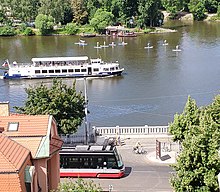

By country
[edit]United Kingdom
[edit]In 2021 the Institute for Public Policy Research issued a statement saying that car use in the United Kingdom must shrink while active transport and public transport should be used more. The Department for Transport responded that they will spend 2 billion pounds on active transport, more than ever, including making England and the rest of the UK's railways greener.[60] UK studies have shown that a modal shift to rail from air could result in a sixty fold reduction in CO2 emissions.[61]
Germany
[edit]Some Western countries are making transportation more sustainable in both long-term and short-term implementations.[62] An example is the modification in available transportation in Freiburg, Germany. The city has implemented extensive methods of public transportation, cycling, and walking, along with large areas where cars are not allowed.[24]
United States
[edit]Since many Western countries are highly automobile-oriented, the main transit that people use is personal vehicles. About 80% of their travel involves cars.[24] Therefore, California, is one of the highest greenhouse gases emitters in the United States. The federal government has to come up with some plans to reduce the total number of vehicle trips to lower greenhouse gases emission. Such as:
- Improve public transport through the provision of larger coverage area in order to provide more mobility and accessibility, new technology to provide a more reliable and responsive public transportation network.[63]
- Encourage walking and biking through the provision of wider pedestrian pathway, bike share stations in downtowns, locate parking lots far from the shopping center, limit on street parking, slower traffic lane in downtown area.
- Increase the cost of car ownership and gas taxes through increased parking fees and tolls, encouraging people to drive more fuel efficient vehicles. This can produce a social equity problem, since lower income people usually drive older vehicles with lower fuel efficiency. Government can use the extra revenue collected from taxes and tolls to improve public transportation and benefit poor communities.[64]
Other states and nations have built efforts to translate knowledge in behavioral economics into evidence-based sustainable transportation policies.[65]
France
[edit]In March 2022, an advertising regulation will come into force in France, requiring all advertising materials for automobiles to include one of three standard disclaimers promoting the use of sustainable transport practices. This applies to all vehicles, including electric vehicles. In 2028, it will also become illegal to advertise vehicles which emit more than 128 grams of carbon dioxide per-kilometre.[66][67]
At city level
[edit]Sustainable transport policies have their greatest impact at the city level.
Some of the biggest cities in Western Europe have a relatively sustainable transport. In Paris 53% of trips are made by walking, 3% by bicycle, 34% by public transport, and only 10% by car. In the entire Ile-de-France region, walking is the most popular way of transportation. In Amsterdam, 28% of trips are made by walking, 31% by bicycle, 18% by public transport and only 23% by car.[68] In Copenhagen 62% of people commute to school or work by bicycle.[69]
Outside Western Europe, cities which have consistently included sustainability as a key consideration in transport and land use planning include Curitiba, Brazil; Bogota, Colombia; Portland, Oregon; and Vancouver, Canada. The state of Victoria, Australia passed legislation in 2010 – the Transport Integration Act[70] – to compel its transport agencies to actively consider sustainability issues including climate change impacts in transport policy, planning and operations.[71]
Many other cities throughout the world have recognized the need to link sustainability and transport policies, for example by joining the Cities for Climate Protection program.[72] Some cities are trying to become car-free cities, e.g., limit or exclude the usage of cars.[73]
In 2020, the COVID-19 pandemic pushed several cities to adopt a plan to drastically increase biking and walking; these included Milan, London, Brighton, and Dublin. These plans were taken to facilitate social distancing by avoiding public transport and at the same time prevent a rise in traffic congestion and air pollution from increase in car use.[74][75] A similar plan was adopted by New York City[76] and Paris.[77] The pandemic's impact on urban public transportation means revenue declines will put a strain on operators' finances and may cause creditworthiness to worsen. Governments might be forced to subsidize operators with financial transfers, in turn reducing resources available for investment in greener transportation systems.[78][79][80]
Community and grassroots action
[edit]Sustainable transport is fundamentally a grassroots movement, albeit one which is now recognized as of citywide, national and international significance.
Whereas it started as a movement driven by environmental concerns, over these last years there has been increased emphasis on social equity and fairness issues, and in particular the need to ensure proper access and services for lower income groups and people with mobility limitations, including the fast-growing population of older citizens. Many of the people exposed to the most vehicle noise, pollution and safety risk have been those who do not own, or cannot drive cars, and those for whom the cost of car ownership causes a severe financial burden.[81]
An organization called Greenxc started in 2011 created a national awareness campaign in the United States encouraging people to carpool by ride-sharing cross country stopping over at various destinations along the way and documenting their travel through video footage, posts and photography.[82] Ride-sharing reduces individual's carbon footprint by allowing several people to use one car instead of everyone using individual cars.
At the beginning of the 21st century, some companies are trying to increase the use of sailing ships, even for commercial purposes, for example, Fairtrannsport and[83] New Dawn Traders[84] They have created the Sail Cargo Alliance.[85]
The European Investment Bank committed €314 million between 2018 and 2022 to green marine transport, funding the building of new ships and the retrofitting of current ships with eco-friendly technologies to increase their energy efficiency and lower harmful emissions.[86][87] The Bank also offered an average of €11 billion per year from 2012 to 2022 for sustainable transportation solutions and climate-friendly initiatives. In 2022, railway projects received around 32% of overall transport loans, while urban mobility received approximately 37%.[88][89]
Recent trends
[edit]
Car travel increased steadily throughout the twentieth century, but trends since 2000 have been more complex. Oil price rises from 2003 have been linked to a decline in per capita fuel use for private vehicle travel in the US,[92] Britain and Australia. In 2008, global oil consumption fell by 0.8% overall, with significant declines in consumption in North America, Western Europe, and parts of Asia.[93]
Other factors affecting a decline in driving, at least in America, include the retirement of Baby Boomers who now drive less, preference for other travel modes (such as transit) by younger age cohorts, the Great Recession, and the rising use of technology (internet, mobile devices) which have made travel less necessary and possibly less attractive.[94]
Greenwashing
[edit]The term green transport is often used as a greenwash marketing technique for products which are not proven to make a positive contribution to environmental sustainability. Such claims can be legally challenged. For instance the Norwegian Consumer Ombudsman has targeted car manufacturers who claim that their cars are "green", "clean" or "environmentally friendly". Manufacturers risk fines if they fail to drop the words.[95] The Australian Competition & Consumer Commission (ACCC) describes "green" claims on products as "very vague, inviting consumers to give a wide range of meanings to the claim, which risks misleading them".[96] In 2008 the ACCC forced a car retailer to stop its green marketing of Saab cars, which was found by the Australian Federal Court to be "misleading".[97]

Tools and incentives
[edit]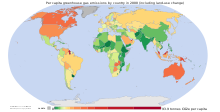
Several European countries are opening up financial incentives that support more sustainable modes of transport. The European Cyclists' Federation, which focuses on daily cycling for transport, has created a document containing a non-complete overview.[98] In the UK, employers have for many years been providing employees with financial incentives. The employee leases or borrows a bike that the employer has purchased. You can also get other support. The scheme is beneficial for the employee who saves money and gets an incentive to get exercise integrated in the daily routine. The employer can expect a tax deduction, lower sick leave and less pressure on parking spaces for cars.[99][100] Since 2010, there has been a scheme in Iceland (Samgöngugreiðslur) where those who do not drive a car to work, get paid a lump of money monthly. An employee must sign a statement not to use a car for work more often than one day a week, or 20% of the days for a period. Some employers pay fixed amounts based on trust. Other employers reimburse the expenses for repairs on bicycles, period-tickets for public transport and the like. Since 2013, amounts up to ISK 8000 per month have been tax-free. Most major workplaces offer this, and a significant proportion of employees use the scheme. Since 2019 half the amount is tax-free if the employee signs a contract not to use a car to work for more than 40% of the days of the contract period.[101][102]
Possible measures for urban transport
[edit]The EU Directorate-General for Transport and Energy (DG-TREN) has launched a program which focusses mostly on urban transport. Its main measures are:
History
[edit]Most of the tools and concepts of sustainable transport were developed before the phrase was coined. Walking, the first mode of transport, is also the most sustainable.[104] Public transport dates back at least as far as the invention of the public bus by Blaise Pascal in 1662.[105] The first passenger tram began operation in 1807 and the first passenger rail service in 1825. Pedal bicycles date from the 1860s. These were the only personal transport choices available to most people in Western countries prior to World War II, and remain the only options for most people in the developing world. Freight was moved by human power, animal power or rail.
Mass motorization
[edit]The post-war years brought increased wealth and a demand for much greater mobility for people and goods. The number of road vehicles in Britain increased fivefold between 1950 and 1979,[50] with similar trends in other Western nations. Most affluent countries and cities invested heavily in bigger and better-designed roads and motorways, which were considered essential to underpin growth and prosperity. Transport planning became a branch of Urban Planning and identified induced demand as a pivotal change from "predict and provide" toward a sustainable approach incorporating land use planning and public transit. Public investment in transit, walking and cycling declined dramatically in the United States, Great Britain and Australia, although this did not occur to the same extent in Canada or mainland Europe.[40][106]
Concerns about the sustainability of this approach became widespread during the 1973 oil crisis and the 1979 energy crisis. The high cost and limited availability of fuel led to a resurgence of interest in alternatives to single occupancy vehicle travel.
Transport innovations dating from this period include high-occupancy vehicle lanes, citywide carpool systems and transportation demand management. Singapore implemented congestion pricing in the late 1970s, and Curitiba began implementing its Bus Rapid Transit system in the early 1980s.
Relatively low and stable oil prices during the 1980s and 1990s led to significant increases in vehicle travel from 1980 to 2000, both directly because people chose to travel by car more often and for greater distances, and indirectly because cities developed tracts of suburban housing, distant from shops and from workplaces, now referred to as urban sprawl. Trends in freight logistics, including a movement from rail and coastal shipping to road freight and a requirement for just in time deliveries, meant that freight traffic grew faster than general vehicle traffic.
At the same time, the academic foundations of the "predict and provide" approach to transport were being questioned, notably by Peter Newman in a set of comparative studies of cities and their transport systems dating from the mid-1980s.[107]
The British Government's White Paper on Transport[108] marked a change in direction for transport planning in the UK. In the introduction to the White Paper, Prime Minister Tony Blair stated that
We recognise that we cannot simply build our way out of the problems we face. It would be environmentally irresponsible – and would not work.
A companion document to the White Paper called "Smarter Choices" researched the potential to scale up the small and scattered sustainable transport initiatives then occurring across Britain, and concluded that the comprehensive application of these techniques could reduce peak period car travel in urban areas by over 20%.[109]
A similar study by the United States Federal Highway Administration,[110] was also released in 2004 and also concluded that a more proactive approach to transportation demand was an important component of overall national transport strategy.
Mobility transition
[edit]
See also
[edit]- Alternatives to car use
- Circular economy
- Cyclability
- Ecological modernization
- Electric bicycle
- Energy efficiency in transport
- Environmental impact of aviation
- Environmental impact of shipping
- Free public transport
- Freeway removal
- Green building
- Green infrastructure
- Green transport hierarchy
- Hypermobility
- Localism
- Modal share
- Michael Replogle
- Road reallocation
- Solar vehicle
- Sustainable architecture
- Sustainable aviation fuel
- Sustainable biofuel
- Sustainable distribution
- Transport ecology
- Urban vitality
- Wind-powered vehicle
Groups:
- EcoMobility Alliance
- Institute for Transportation and Development Policy
- International Association of Public Transport
- Michelin Challenge Bibendum
References
[edit]- ^ Jeon, C M; Amekudzi (March 2005), "Addressing Sustainability in Transportation Systems: Definitions, Indicators, and Metrics" (PDF), Journal of Infrastructure Systems, 11: 31–50, doi:10.1061/(ASCE)1076-0342(2005)11:1(31), archived (PDF) from the original on 2016-03-03, retrieved 2012-11-21
- ^ World Energy Council (2007). "Transport Technologies and Policy Scenarios". World Energy Council. Archived from the original on 2008-12-04. Retrieved 2009-05-26.
- ^ "About Transportation & Climate Change: Transportation's Role in Climate Change: Overview - DOT Transportation and Climate Change Clearinghouse". climate.dot.gov. Archived from the original on 2015-10-31. Retrieved 2015-11-15.
- ^ "Get on the bus first to make Nicosia tram infrastructure worth the investment". European Investment Bank. Retrieved 2022-09-01.
- ^ "Transport emissions". ec.europa.eu. Retrieved 2022-09-01.
- ^ a b c Intergovernmental Panel on Climate Change (2007). "IPCC Fourth Assessment Report: Mitigation of Climate Change, chapter 5, Transport and its Infrastructure" (PDF). Intergovernmental Panel on Climate Change. Archived (PDF) from the original on 2008-07-18. Retrieved 2009-05-26.
- ^ "National multipollutant emissions comparison by source sector in 2002". US Environmental Protection Agency. 2002. Archived from the original on 2019-06-30. Retrieved 2009-03-18.
- ^ Schafer, A. (1998) "The global demand for motorized mobility." Transportation Research A 32(6), 455-477.
- ^ "LEDS in Practice: Fight poverty". Low Emission Development Strategies Global Partnership (LEDS GP). Archived from the original on 2016-06-24. Retrieved 2016-05-25.
- ^ Helping to Build a Safe and Sustainable Transportation Infrastructure (PDF), U.S. Department of Transportation's Research and Innovative Technology Administration, May 2010, archived (PDF) from the original on 2017-07-10, retrieved 2012-11-21
- ^ "Air pollution: World's worst Environmental health risk" (PDF). United Nations Environment Programme (UNEP). Archived (PDF) from the original on 2016-04-14. Retrieved 2016-05-25.
- ^ a b "LEDS in Practice: Breathe clean". Low Emission Development Strategies Global Partnership (LEDS GP). Archived from the original on 2018-12-19. Retrieved 2016-05-25.
- ^ "What are connected autonomous vehicles?". European Investment Bank. Retrieved 2023-08-21.
- ^ a b World Health Organisation, Europe. "Health effects of transport". Archived from the original on 2010-04-30. Retrieved 2008-08-29.
- ^ Social Exclusion Unit, Office of the Prime Minister (UK). "Making the Connections - final report on transport and social exclusion" (PDF). Archived from the original (PDF) on 2010-09-07. Retrieved 2003-02-01.
- ^ Todd Litman (1998). "Measuring Transportation: Traffic, Mobility and Accessibility" (PDF). Victoria Transport Policy Institute. Archived (PDF) from the original on 2018-05-16. Retrieved 2009-03-18.
- ^ Todd Litman (2009). "Sustainable Transportation and TDM". Online TDM Encyclopedia. Victoria Transport Policy Institute. Archived from the original on 2020-05-13. Retrieved 2009-04-07.
- ^ Strategies for Managing Impacts from Automobiles, US EPA Region 10, archived from the original on March 4, 2016, retrieved May 22, 2012
- ^ "European Union's End-of-life Vehicle (ELV) Directive", End of Life Vehicles, EU, archived from the original on January 29, 2015, retrieved May 22, 2012
- ^ "LEDS in Practice: Create jobs". The Low Emission Development Strategies Global Partnership. Archived from the original on 2016-11-11. Retrieved 2021-09-07.
- ^ "LEDS in Practice: Make roads safe". The Low Emission Development Strategies Global Partnership. Archived from the original on 2018-12-18. Retrieved 2021-09-07.
- ^ "LEDS in Practice: Save money and time". The Low Emission Development Strategies Global Partnership. Archived from the original on 2016-11-11. Retrieved 2021-09-07.
- ^ "Van Hool presents the ExquiCity Design Mettis". Archived from the original on 5 June 2013. Retrieved 5 June 2012.
- ^ a b c Buehler, Ralph; Pucher, John (2011). "Sustainable Transport in Freiburg: Lessons from Germany's Environmental Capital". International Journal of Sustainable Transportation. 5 (1): 43–70. Bibcode:2011IJSTr...5...43B. CiteSeerX 10.1.1.233.1827. doi:10.1080/15568311003650531. S2CID 17652577.
- ^ Pearce, Joshua M.; Johnson, Sara J.; Grant, Gabriel B. (2007). "3D-Mapping Optimization of Embodied Energy of Transportation". Resources, Conservation and Recycling. 51 (2): 435–453. Bibcode:2007RCR....51..435P. CiteSeerX 10.1.1.394.9520. doi:10.1016/j.resconrec.2006.10.010. Archived from the original on 16 January 2014. Retrieved 1 March 2018.
- ^ "LEDS in Practice: Breathe clean". The Low Emission Development Strategies Global Partnership. Archived from the original on 2018-12-19. Retrieved 2016-05-25.
- ^ Gabrielli G, and von Karman Th, "What price speed?," Mechanical Engineering, Vol 72, pp. 775-781, 1950.
- ^ Dewulf J, and Van Langenhove H., "Exergetic material input per unit of service (EMIPS) for the assessment of resource productivity of transport commodities". Resources Conservation and Recycling. 38(2), Pages: 161–174 (2003).
- ^ Chester M, and Horvath A, Environmental Assessment of Passenger Transportation Should Include Infrastructure and Supply Chains, Environmental Research Letters 4(2), 2009.
- ^ Chester M, and Horvath A, High-speed Rail with Emerging Automobiles and Aircraft Can Reduce Environmental Impacts in California's Future, Environmental Research Letters 7(3), 2012.
- ^ Chester et al., "Infrastructure and Automobile Shifts: Positioning Transit to Reduce Life-cycle Environmental Impacts for Urban Sustainability Goals", Environmental Research Letters 8(1), 2012
- ^ Trancossi, M. (2014). "What price of speed? A critical revision through constructal optimization of transport modes". International Journal of Energy and Environmental Engineering. 7 (4): 425–448. doi:10.1007/s40095-015-0160-6.
- ^ Heather L. MacLean and Lester B. Lave University of Toronto (2003). "OECD's Economic Assessment of Biofuel Support Policies". Environmental Science & Technology. 37 (23): 5445–5452. doi:10.1021/es034574q. PMID 14700331. S2CID 6268340.
- ^ a b c d Bieker, Georg (2021). A Global Comparison of the Life-Cycle Greenhouse Gas Emissions of Combustion Engine and Electric Passenger Cars. Berlin: International Council on Clean Transportation Europe. p. ii.
- ^ "Comparative life-cycle greenhouse gas emissions of a mid-size BEV and ICE vehicle – Charts – Data & Statistics". IEA. Retrieved 2023-09-20.
- ^ Hausfather, Zeke (2019-05-13). "Factcheck: How electric vehicles help to tackle climate change". Carbon Brief. Archived from the original on 2021-08-25. Retrieved 2021-06-05.
- ^ Global Fuel Economy Initiative 2021. Paris: International Energy Agency. November 2021. p. 14.
- ^ "KAIST's wireless Online Electric Vehicle (OLEV) runs inner city roads". KAIST.edu. Korea Advanced Institute of Science and Technology. 2013-08-07. Archived from the original on 2013-12-31. Retrieved 2013-12-31.
- ^ OECD. "OECD's Economic Assessment of Biofuel Support Policies". Archived from the original on 2009-05-15. Retrieved 2009-07-31.
- ^ a b "Making Transit Work: insight from Western Europe, Canada and the United States" (PDF). Transportation Research Board. 2001. Archived (PDF) from the original on 2017-08-08. Retrieved 2008-07-22.
- ^ U.S. Centers for Disease Control and Prevention. "Active Transportation to School Then and Now — Barriers and Solutions". KidsWalk-to-School: Resource Materials - DNPAO - CDC. Archived from the original on 2010-03-09. Retrieved 2008-07-22.
- ^ "An interview with Dr Reid Ewing". Relationship between urban sprawl and physical activity, obesity, and morbidity. American Journal of Health Promotion 18[1]: 47-57. September–October 2003. Archived from the original on 2006-03-15. Retrieved 2008-07-25.
- ^ "Tackling transport-related barriers to employment in low-income neighbourhoods". JRF. 2018-08-06. Archived from the original on 2021-04-13. Retrieved 2021-04-13.
- ^ Mattioli, Giulio (28 December 2017). "'Forced Car Ownership' in the UK and Germany: Socio-Spatial Patterns and Potential Economic Stress Impacts". Social Inclusion. 5 (4): 147–160. doi:10.17645/si.v5i4.1081.
- ^ Dzisi, Emmanuel Komla Junior; Lugada, Tracy (July 2021). "Modeling the potential shift from motorcycles (boda bodas) to bicycles among young people on a Ugandan university campus". Scientific African. 12: e00741. Bibcode:2021SciAf..1200741D. doi:10.1016/j.sciaf.2021.e00741. S2CID 233538995.
- ^ Ellis, Cliff (2005). "Lewis Mumford and Norman Bel Geddes: the highway, the city and the future". Planning Perspectives. 20 (1): 51–68. Bibcode:2005PlPer..20...51E. doi:10.1080/0266543042000300537. S2CID 220329372.
- ^ James Howard Kunstler (1993). The Geography of Nowhere.
- ^ Lewis Mumford (11 July 2008). "Lewis Mumford on the City". YouTube. Archived from the original on 2010-02-13. Retrieved 2009-03-18.
- ^ Hillman, Mayer (2014-08-10). "Children Key publications". Key publicatonson children's quality of life by Dr. Mayer Hillman. Archived from the original on 2009-02-03. Retrieved 2009-03-18.
- ^ a b "Transport Statistics Great Britain 2008: Section 9, Vehicles" (PDF). Archived from the original (PDF) on 2009-01-03. Retrieved 2009-03-18.
- ^ van den Hoorn, T & B van Luipen (2003). "National and Regional Transport Policy in the Netherlands" (PDF). Archived from the original (PDF) on 2011-07-24. Retrieved 2008-07-27.
- ^ a b Kenworthy, J R Transport Energy Use and Greenhouse Emissions in Urban Passenger Transport Systems : A Study of 84 Global Cities Archived 2008-09-09 at the Wayback Machine Murdoch University
- ^ Ewing, Reid & Cervero, Robert (2001). "Travel and the Built Environment: A Synthesis" (PDF). Transportation Research Record, 1780: 87-114. 2001. Archived (PDF) from the original on 2016-10-20. Retrieved 2008-07-22.
- ^ "New York City's Green Dividend" (PDF). CEOs for Cities. 2009. Archived (PDF) from the original on 2021-02-07. Retrieved 2010-05-15.
- ^ "Seeing the back of the car". The Economist. 2012-09-22. Archived from the original on 2013-05-20. Retrieved 2012-09-23. Published in the Sept 22nd 2012 print edition.
- ^ "How are social enterprises helping address road safety and transportation challenges in India?". Archived from the original on 2014-03-25. Retrieved 2014-03-25.
- ^ "Transport: Action Plan on urban mobility - European commission". Archived from the original on May 29, 2010. Retrieved September 1, 2019.
- ^ "C40: 35 CITIES UNITE TO CLEAN THE AIR THEIR CITIZENS BREATHE, PROTECTING THE HEALTH OF MILLIONS". C40.org. Archived from the original on 2019-12-07. Retrieved 2019-12-11.
- ^ Dasgupta, Susmita; Lall, Somik; Wheeler, David (2023-07-20). "Subways and CO2 emissions: A global analysis with satellite data". Science of the Total Environment. 883: 163691. doi:10.1016/j.scitotenv.2023.163691. ISSN 0048-9697. PMID 37100143. S2CID 258327571.
- ^ Harrabin, Roger (23 June 2021). "Climate change: Set target to cut car use, minister told". BBC. Archived from the original on 22 June 2021. Retrieved 23 June 2021.
- ^ Shirres, David (June 2023). Sherratt (ed.). "DfT understates the benefits of modal shift". Modern Railways. 80 (897). Key Publishing: 62–63. ISSN 0026-8356.
- ^ Barbour, Elissa and Elizabeth A. Deakin. 2012. "Smart Growth Planning for Climate Protection"
- ^ Murthy, A.S. Narasimha Mohle, Henry. Transportation Engineering Basics (2nd Edition)[permanent dead link]. (American Society of Civil Engineers 2001).
- ^ Levine, Jonathan. 2013. "Urban Transportation and Social Equity: Transportation Planning Paradigms that Impede Policy Reform," in Naomi Carmon and Susan S. Fainstein, eds. Policy, Planning and people: promoting Justice in Urban Development (Penn)
- ^ "mobilizing sustainable transport for development" (PDF). Archived (PDF) from the original on 2021-05-14. Retrieved 2021-09-07.
- ^ "France will force car ads to place messages encouraging cycling, walking". CTV News. 2021-12-30. Retrieved 2022-01-04.
- ^ "'Opt for cycling': French car ads required to back travel alternatives from 2022". France 24. 2021-12-31. Retrieved 2022-01-04.
- ^ Vigneau, Laurent (30 May 2018). "On foot or by bike? While Paris walks, Amsterdam pedals". Medium. La Fabrique de la Cité. Archived from the original on 7 August 2020. Retrieved 13 May 2020.
- ^ KIRSCHBAUM, ERIK (8 August 2019). "Copenhagen has taken bicycle commuting to a whole new level". Los Angeles Times. Archived from the original on 23 November 2021. Retrieved 13 May 2020.
- ^ "Transport Integration Act 2010" (PDF). Archived (PDF) from the original on April 12, 2016. Retrieved September 1, 2019.
- ^ Transport Integration Act 2010, Part 2 - see http://www.legislation.vic.gov.au Archived 2011-02-05 at the Wayback Machine.
- ^ "ICLEI Local Governments for Sustainability". Cities for Climate Protection. International Council for Local Environmental Initiatives. 1995–2008. Archived from the original on 2009-03-07. Retrieved 2009-03-18.
- ^ Barber, Megan (17 May 2017). "14 gorgeous car-free cities around the world". Curbed. Vox Media. Archived from the original on 7 April 2020. Retrieved 7 April 2020.
- ^ Laker, Laura (21 April 2020). "Milan announces ambitious scheme to reduce car use after lockdown". The Guardian. Archived from the original on 22 April 2020. Retrieved 23 April 2020.
- ^ Corbett, Jessica (16 May 2020). "'Car-Free Zones' Launching in London". Ecowatch. Archived from the original on 23 May 2020. Retrieved 20 May 2020.
- ^ BUDRYK, ZACK (27 April 2020). "New York City to open 100 miles of city streets to pedestrians". THE HILL. Archived from the original on 11 May 2020. Retrieved 20 May 2020.
- ^ "Paris to roll out 50km of cycle lanes to stop spread of Covid-19 on public transport". The local. 12 May 2020. Archived from the original on 18 May 2020. Retrieved 13 May 2020.
- ^ "Urban mobility gets a rethink after COVID-19". European Investment Bank. Retrieved 2022-09-01.
- ^ "Protecting public transport from the coronavirus... and from financial collapse". blogs.worldbank.org. 24 April 2020. Retrieved 2022-09-01.
- ^ Welle, Ben; Berg, Rogier van den; Adriazola-Steil, Claudia (2022-02-03). "3 Ways to Reimagine Public Transport for People and the Climate". World Resources Institute.
- ^ "Making the Connections: Final report on transport and social exclusion". UK Social Exclusion Unit. February 2003. Archived from the original on 2008-05-21. Retrieved 2008-07-22.
- ^ "GreenXC". GreenXC Website. Archived from the original on 2011-06-04. Retrieved 2021-11-23.
- ^ "About Fairtransport". Fairtransport. Archived from the original on 10 May 2020. Retrieved 5 April 2020.
- ^ "New Dawn Traders". New Dawn Traders. Archived from the original on 19 May 2020. Retrieved 5 April 2020.
- ^ "Sail Cargo Alliance". Sail Cargo Alliuance. Archived from the original on 8 January 2020. Retrieved 5 April 2020.
- ^ Bank, European Investment (2023-08-17). Clean oceans and the blue economy Overview 2023. European Investment Bank. ISBN 978-92-861-5518-5.
- ^ "Review of maritime transport 2021" (PDF).
- ^ European Investment Bank (2023-09-11). Sustainable transport overview 2023 (Report).
- ^ "Transport Lending Policy 2022" (PDF). eib.org.
- ^ "Global EV Outlook 2023 / Trends in electric light-duty vehicles". International Energy Agency. April 2023. Archived from the original on 12 May 2023.
- ^ Data from McKerracher, Colin (12 January 2023). "Electric Vehicles Look Poised for Slower Sales Growth This Year". BloombergNEF. Archived from the original on 12 January 2023.
- ^ "Transportation Energy Data Book". US Department of Energy. 2009. Archived from the original on 2009-03-12. Retrieved 2010-05-14.
- ^ "BP Statistical Review of World Energy 2009". BP. 2009. Archived from the original on 2011-06-08. Retrieved 2010-05-14.
- ^ "A New Direction". 2013. U.S. PIRG. Archived from the original on 29 September 2013. Retrieved 15 October 2013.
- ^ "Norways Says Cars Neither Green Nor Clean". Reuters.com. 2007-09-06. Archived from the original on 2009-05-16. Retrieved 2009-10-04.
- ^ ACCC: Green marketing and the Trade Practices Act, 2008 Archived 2010-12-12 at the Wayback Machine. Retrieved 2009-10-04.
- ^ 'Drive.com.au: Coming clean on green Archived 2012-02-22 at the Wayback Machine. Retrieved 2009-10-04.
- ^ Commuting: Who pays the bill Archived 2017-07-25 at the Wayback Machine, Retrieved 2019-01-14
- ^ Bike2Work Scheme Archived 2019-03-25 at the Wayback Machine, Retrieved 2019-01-14
- ^ CycleScheme Archived 2019-03-25 at the Wayback Machine, Retrieved 2019-01-14
- ^ Kostnaður fyrirtækja við gerð og viðhald á bílastæðum er mikill. Nú bjóða ýmis fyrirtæki starfsfólki sínu upp á samgöngusamning en þá skuldbindur starfsmaðurinn sig til þess að fara ekki á einkabíl til og frá vinnu og fær í staðinn ákveðna greiðslu. Slíkt býðst t.d. starfsfólki Umhverfisstofnunar. Archived 2019-01-14 at the Wayback Machine, Retrieved 2019-01-14
- ^ Skattmat Archived 2019-03-21 at the Wayback Machine, Retrieved 2019-01-31
- ^ "Online TDM Encyclopedia - About This Encyclopedia". Archived from the original on 2010-07-06. Retrieved 2010-05-24.
- ^ "Walking benefits". Transport for London. Archived from the original on 2014-02-28. Retrieved 2009-05-16.
- ^ "March 18, 1662: The Bus Starts Here ... in Paris". Wired. 2008-03-18. Archived from the original on 2009-05-22. Retrieved 2009-05-16.
- ^ "Promoting Safe Walking and Cycling to Improve Public Health:Lessons from The Netherlands and Germany" (PDF). American Journal of Public Health, Vol. 93. Archived (PDF) from the original on 2021-02-22. Retrieved 2008-08-30.
- ^ Cities and Automobile Dependence: An International Sourcebook, Newman P and Kenworthy J, Gower, Aldershot, 1989
- ^ "White Paper on Transport". 2004. Archived from the original on 2010-02-06. Retrieved 2009-07-04.
- ^ Cairns, S; et al. (July 2004). "Smarter Choices, Changing the Way we Travel page v". Archived from the original on June 14, 2007. Retrieved 2008-07-27.
- ^ "Mitigating Traffic Congestion". 2004. Archived from the original on 2018-12-08. Retrieved 2009-07-04.
- ^ Adey et al. 2021, p. 4.
- ^ Shiftan, Yoram (2016). Transition towards Sustainable Mobility: The Role of Instruments, Individuals and Institutions. Abingdon: Routledge. pp. 65–68. ISBN 9781317007302. Retrieved 26 February 2022.
- ^ Gianna Niewel (2020-03-02). "Verkehrswende in München – Das Drama einer Umverteilung". Süddeutsche Zeitung. Retrieved 2020-03-05.
Bibliography
[edit]- Adey, Peter; Cresswell, Tim; Lee, Jane Yeonjae; Nikolaeva, Anna; Nóvoa, André; Temenos, Cristina (2021). Moving Towards Transition: Commoning Mobility for a Low-Carbon Future. London: Bloomsbury Publishing. p. 4. ISBN 9781786998989. Retrieved 26 February 2022.
- Sustainability and Cities: Overcoming Automobile Dependence, Island Press, Washington DC, 1999. Newman P and Kenworthy J, ISBN 1-55963-660-2.
- Sustainable Transportation Networks, Edward Elgar Publishing, Cheltenham, England, 2000. Nagurney A, ISBN 1-84064-357-9
- Introduction to Sustainable Transportation: Policy, Planning and Implementation, Earthscan, London, Washington DC, 2010. Schiller P Eric C. Bruun and Jeffrey R. Kenworthy, ISBN 978-1-84407-665-9.
- Sustainable Transport, Mobility Management and Travel Plans, Ashgate Press, Farnham, Surrey, 2012, Enoch M P. ISBN 978-0-7546-7939-4.
External links
[edit]- Guiding Principles to Sustainable Mobility
- Sustainable Urban Transport Project - knowledge platform (SUTP)
- German Partnership for Sustainable Mobility (GPSM)
- Bridging the Gap: Pathways for transport in the post 2012 process
- Sustainable-mobility.org: the centre of resources on sustainable transport
- Transportation Research at IssueLab
- Switching Gears: Enabling Access to Sustainable Urban Mobility

